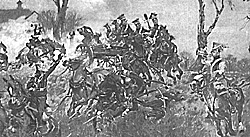Dispatches
Letters to the Editor
by the readers
| |
Thank you for another splendid issue of First Empire. Here is just a minor correction on an aspect of Duchy of Warsaw uniforms and organisation. In First Empire 58, on page 4, there is a note to the picture by W. Kossak of “A Battery under fire at Raszyn”. The note reads, “the drivers shown here have green kurtkas as opposed to the regulation slate grey”. Despite not bring contemporary artists, the Kossaks (there was a family of artists) generally got their uniforms correct, so I checked in other sources. Malibran and Chelminski quote the uniform regulations for the Duchy of Warsaw, but these do not specifically cover artillery drivers, while the train (supply column) personnel are not mentioned. However, Gembarzewski, who quotes the contemporary sources his drawings are based on, has several examples of artillery drivers. These all have dark green coats, both for the horse artillery and the foot artillery. In his captions, the drivers are sometimes referred to as gunners. The drivers belonging to the train are shown with slate-grey kurtkas. It therefore appears that the Duchy of Warsaw, unlike the British army, did not place its artillery drivers in a separate corps but counted them as artillery personnel and included them in the company organisation. It is noticeable that the actual coats worn by artillery drivers are sometimes not the full dress kurtka, so a realist might point out that W. Kossak perhaps ought not to have the subjects of his painting in full dress. However, I would retort that, if those gunners knew that they were to be be shown in a painting, they would certainly have taken the trouble to put on their full dress! Sources referred to: Chelminski, J. V. and Malibran, A. L’Armée du Duché de Varsovie, Paris (recently reprinted) ISBN 2-914288-02-6
From Le Moniteur Richard Knötel Posted by: Manuel Britos Dear Friends: I would like to know where we can find the Knötel’s illustrations in colours.The illustrations that we can find in books like Nafziger or Muller-Bhon or Pflug-Harttung but in B&W ( specially the battles scenes ) Thank you for your help. Manuel Posted by: Dave Hollins The National Art Library in the V&A has a large collection of the Knotel Senior pictures (he ran them off a Newsletter) but they are of varying accuracy. For the battle scenes, try the Anne SK Brown Lirary in the USA who will sell you photos from various old books at a reasonable price. Westfalian Kurassiers Posted by: John Walsh Can anyone tell me if I’m correct/incorrect, in assuming that the Westfalian (Westphalian?) Kurassiers, when fighting on the French side, did not take part or enter Spain or Portugal at any time? Going by Men-At-Arms 44, Napoleon’s German Allies No 1, it seems that they didn’t. But I just want to make sure. I’m hoping that they did but I’ll welcome any advice/info, no matter how small. Unfortunately, I have looked through numerous books in my collection and can find no reference to Westfalian (or Westphalian) Kurassiers being present in the Peninsula. Generally, Cuirassiers Regiments were not sent to the Peninsula, as their weighty equipment and slow, lumbering mounts made them worse than useless at hunting guerrillas - another reason for their absence was Napoleon’s insistence on having his big brothers as a Cavalry Reserve on campaign. However, despite all that’s written above, there does appear to have been Westphalian troops in the Peninsula during the conflict. Unfortunately, they made a poor impression on Napoleon who complained that “of all the German soldiers, they are the least to be depended on.” Just for additional info, there appear to have two Westphalian Kurassier units, the second formed in 1812. Both, I believe, were present during the Russian campaign, and perished along with most of Napoleon’s other cavalry units. Napoleon did not approve of his brother, Jerome, King of Westphalia, forming kurassiers regiments as they were expensive to outfit and maintain and Jerome rather slapdash approach to financial management saw the Kingdom of Westphalia close to bankruptcy for most of its six year existence as a Napoleonic dependency. Sources: The Napoleonic Sourcebook by P J Haythornthwaite
Answer: Westphalian Kurassiers [FE60] Back to Table of Contents -- First Empire #59 Back to First Empire List of Issues Back to MagWeb Master Magazine List © Copyright 2001 by First Empire. This article appears in MagWeb (Magazine Web) on the Internet World Wide Web. Other military history articles and gaming articles are available at http://www.magweb.com |
